30 F. high temperature at KSTC Wednesday.
32 F. average high on March 2.
27 F. high on March 2, 2015.
March 3, 1977: A snowstorm results in over 400 school closings in Minnesota and Wisconsin.
Forecast Dilemmas - Maps Look Like Late March
The forecast is rarely simple, cut and dry. Unless you're a comatose weather dude in Phoenix or San Diego during the summer months.
Predicting temperature is more straightforward than precipitation. Timing is easier with fall, winter and spring storms, when rain and snow is "stratiform" - widespread smears of moisture, as opposed to random, hit or miss "convective" summer thundershowers.
And do you predict the forecast high/low at MSP International Airport, where the official recordings are taken? Downtown temperatures can be 3-8F warmer than outlying suburbs due to the urban heat island.
One of many meteorological quandaries we deal with on a daily basis.
There's little doubt temperatures will mellow into next week; probably an extended run of 50s with a 1 in 3 chance of 60F on Tuesday. That's 20F warmer than average, coming after a February 4F warmer than normal. I detect a trend.
No mega-storms brewing, maybe a light mix Friday night; the atmosphere warm enough for generic rain showers by Monday - thunder by Tuesday.
On the blog below: are extreme tornado outbreaks becoming more common - and February was the warmest month in the satellite record.
Map credit above: "Global
temperatures hit a new all-time record high in February, shattering the
old record set just last month amid a record-strong El Niño." Ryan Maue/Weatherbell Analytics.
Image credit above: "Temperature departure from normal over Earth in February 2016." (Roy Spencer, University of Alabama at Huntsville).
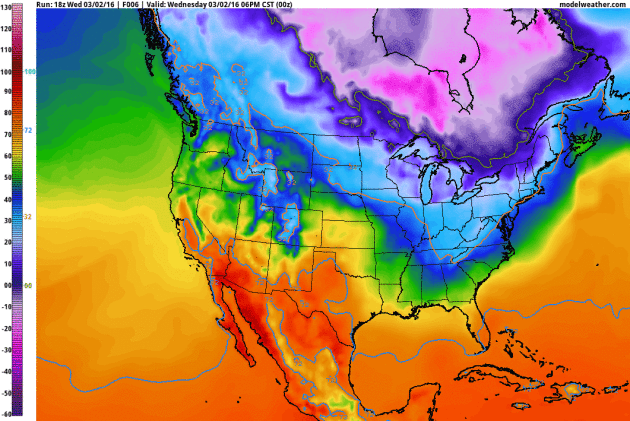
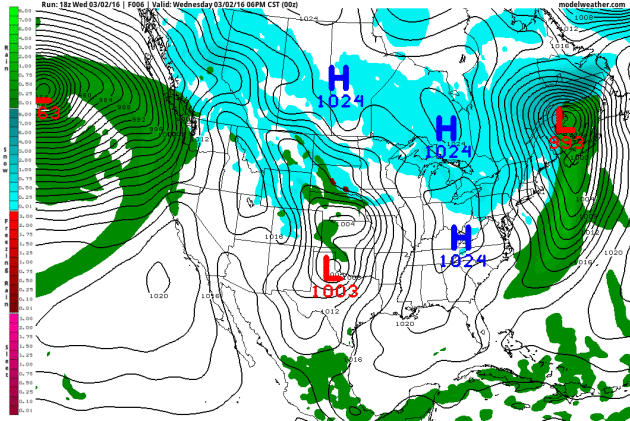
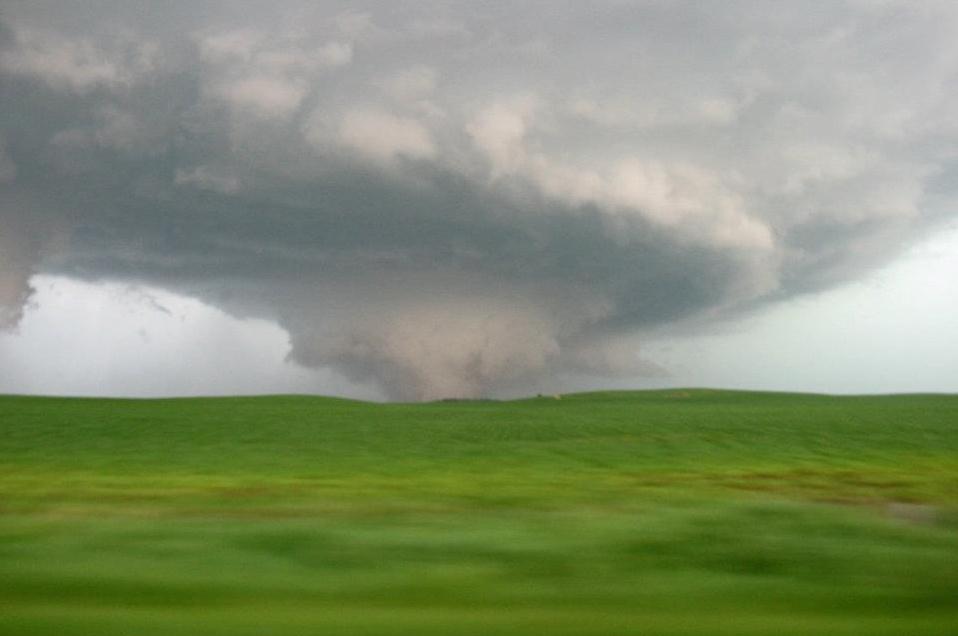
Extreme Tornado Outbreaks Have Become More Common. New research highlighted at The International Research Institute for Climate Policy at Columbia University's Earth Institute made me do a double-take; here's the intro: "Most death and destruction inflicted by tornadoes in North America occurs during outbreaks—large-scale weather events that can last one to three days and span huge regions. The largest outbreak ever recorded happened in 2011. It spawned 363 tornadoes across the United States and Canada, killing more than 350 people and causing $11 billion in damage. Now, a new study shows that the average number of tornadoes in these outbreaks has risen since 1954, and that the chance of extreme outbreaks —tornado factories like the one in 2011—has also increased. The study’s authors said they do not know what is driving the changes. “The science is still open,” said lead author Michael Tippett, a climate and weather researcher at Columbia University’s School of Applied Science and Engineering and Columbia’s Data Science Institute..." (The paper below is available at Nature Communications).
Photo credit above: Meteorologist Aaron Shaffer, minnyapple.com.
What Does a Warming Arctic Have to do with snow in New England? Plenty. Here's an excerpt of a fascinating story at Alaska Dispatch: "Isotopes in water molecules act like a “chemical fingerprint,” said Jeff Welker, a UAA biology professor involved in the project. Analysis by Welker, UAA postdoctoral fellow Eric Klein and their research partners at the State University of New York and other institutions parsed out the isotopes associated with the Arctic -- considered a cold, dry source of water -- and matched them to the heavy precipitation events at the New Hampshire location. The analysis also tracked increasing incidences of Arctic-marked rain and snowfall over time with reduced Arctic sea ice -- and with polar vortex events like the one that warmed Alaska but chilled the U.S. East Coast in the winter of 2013-14. The chemical evidence backs up the emerging theory that the rapid warming of the Arctic is slowing the jet stream, causing a wavy pattern that brings warm weather to the far north and cold weather to the middle latitudes, Welker and Klein said..."
Photo credit above: "In this Feb. 23, 2015 file photo, a car remains buried in snow along a residential street in South Boston. Boston's 2015 winter was also its snowiest season going back to 1872. Now, researchers have determined that all that snow in the Northeast U.S. may be due in part to warming in the Arctic." Elise Amendola / Associated Press file photo
El Nino Eases to Moderate Levels. Reuters has the story.
El Nino, La Nina: How Do They Mess With Our Weather? The Washington Post
has a good overview, but it's worth remembering that every El Nino warm
phase and La Nina cool phase is different. The weather never repeats,
but sometimes it rhymes. Here's an excerpt: "...Warmer waters favor
low pressure and convection, or the development of thunderstorm
activity. This allows for some ENSO-based seasonal weather
predictability around the globe. The wet pattern is focused where the
ocean waters are relatively warmer. Therefore, La Niña often brings
floods to Southeast Asia and Oceania and drought to the Americas, as
eastern Pacific waters are cooler. El Niño frequently presents the
reverse effects. In North America, ENSO modifies the jet stream, which
carries and distributes weather patterns from west to east. Warmer
winters are generally expected during El Niño because the jet stream
takes on a more southerly track, fighting off Arctic air domination..."
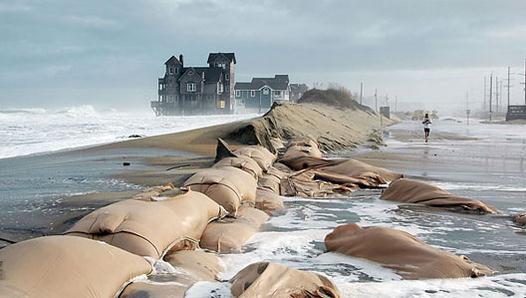
Flood Damage Costs Will Rise Faster Than Sea Levels, Study Says.
Will the costs of coastal flooding rise exponentially? Many communities
are already feeling the pain, according to new research highlighted at InsideClimate News: "...So far, the investigation of flood-related damages has lagged behind studies on sea level rise, said Jürgen Kropp, one of the study authors and a climate scientist at the Potsdam Institute for Climate Impact Research in Potsdam, Germany. This new study,
published Monday in the journal Natural Hazards and Earth System
Sciences, comes on the heels of two related climate papers. One found
that the current rate of sea level rise is the fastest on record for at least the last 28 centuries. The study, by researchers from seven institutions including Potsdam, was published last week in the journal Proceedings of the National Academy of Sciences. The other, by scientists at Climate Central, concluded
that the coastal flooding of American towns and cities will continue to
intensify in the future due to manmade global warming..." (File credit: Andrew Demp, Yale).
Why Are So Many People Still Living in Flood-Prone Cities? Easy transportation and trade is one answer, but that comes with a downside as seas continue to rise. Here's a clip from The Conversation: "Over the last 30 years, floods have killed more than 500,000 people globally, and displaced about 650m more. In a recent paper
published by the Centre for Economic Performance, we examined why so
many people are hit by devastating floods. We looked at 53 large floods,
which affected more than 1,800 cities in 40 countries, from 2003 to
2008. Each of these floods displaced at least 100,000 people from their
homes. Of course, part of the problem is that many cities were
originally built near rivers and coastlines. For a long time, these
cities’ residents benefited from lower transport costs, because they were close to ports and the trade which occurred there..."
Photo credit above: johnmcq/Flickr, CC BY-NC
Photo credit: "A Syrian refugee camp in Turkey." Credit: European Parliament.
Photo credit above: "A man feeds shrimps at a farm in Vietnam's Mekong delta province of Ben Tre August 22, 2015." REUTERS/Kham.
Listen Up Candidates: Science Matters, and Here's Why. Scientific American has a link to a good explainer video: "Because researchers work on solving problems that every politician should care about—including climate risks, clean energy, new materials, emerging diseases and a wide range of technologies that can fuel economic growth—the Science Coalition, a group of universities that lobbies for federal investments in research, is sponsoring an event called Super Science Tuesday. It's a video compilation in which scientists tell the candidates why they need to pay attention..."
Image credit: National Human Genome Research Institute, National Institutes of Health.
The Challenge of Taming Air Turbulence. Keep your seatbelt fastened at all times. Here's an excerpt of an article at The New York Times: "...Turbulence
is the leading cause of injuries to passengers and crew aboard
commercial aircraft, according to the Federal Aviation Administration.
In 2015, 21 people — 14 crew members and seven passengers — were injured
by turbulence, according to the F.A.A.; in 2014, 31 people were
injured, nine crew members and 22 passengers. The worst recent year was
2010, when 76 people — 25 crew members and 51 passengers — were injured
by turbulence. There are many different kinds of turbulence, with the
most problematic to predict and to avoid being clear air turbulence
(which is very difficult to detect using conventional radar). Much of it
is typically experienced at cruising altitude..."
File photo credit: Alamy.
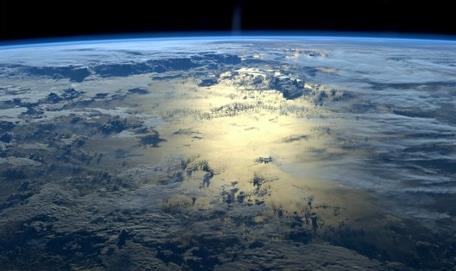
File image: NASA ISS.
Wind on Track to Top Hydro as the Leading U.S. Renewable After 2017. Here's the intro to a story at Utility Dive: "Hydropower, long the leading source of renewable energy in the United States, is slated to be overtaken by wind generation by the end of 2017, Generation Hub reports. At the end of 2015, wind accounted for 6.33% of the U.S. power mix and hydro made up 8.41%. There are 12,329 MW of wind in construction or planning but only 317 MW of hydropower capacity in construction or planning at present, according to recent FERC numbers. By the end of 2017, wind is likely to account for about 8.4% of the U.S. electricity supply and challenge hydro for the U.S. renewables lead..."
Best Pictures from #YearInSpace. Check out some amazing photos taken by NASA astronaut Scott Kelly on the International Space Station, courtesty of Flickr.
Milan May Become The Biggest City Yet to Pay People to Bike to Work Instead of Taking Cars. Quartz has the story; here's a snippet: "More than 5.5 million around the world die prematurely every year due to air pollution—it’s the biggest environmental health risk.
In a bid to tackle air pollution, governments are desperate to get
people to stop using cars. Italy’s economic powerhouses, Milan and Rome,
have had to restrict car use for several days
as a result of dangerous smog build up, and Milan—with a population of
1.25 million people and among the most polluted cities in Europe—is the
latest city to propose paying commuters to bike to work..."
Photo credit above: "Come and get it." (Reuters/Fabrizio Bensch).
The Car Century Was a Mistake. It's Time To Move On.
Hey, I love my car but between parking, insurance, soul-sucking
traffic, safety and pollution impacts there may be a better way for
urban-dwellers. Here's an excerpt of a story at The Washington Post: "...Cars
were never necessary in cities, and in many respects they worked
against the fundamental purpose of cities: to bring many people together
in a space where social, cultural and economic synergies could develop.
Because cars require so much space for movement and parking, they work
against this objective — they cause cities to expand in order to provide
the land cars need. Removing cars from cities would help to improve the
quality of urban life..."
Image credit above: "Many
streets in the oldest part of Quebec City are car-free much of the
time. It is one of the most extensive car-free areas in North America." (CarfreeCities).
The Obsessive Treasure Hunters Who Travel the World with Metal Detectors. But do they have issues with TSA trying to get these contraptions through metal detectors? Here's a clip from Atlas Obscura: "...In
recent years, metal detecting has hit a kind of pop cultural sweet
spot: The National Geographic Channel produces a reality show called Diggers and the BBC comedy The Detectorists, which follows the exploits of a fictional metal detecting club, has scored critical acclaim. Enthusiasts can indulge in punny t-shirts (“I dig booty”) or groove to 13 songs about metal detecting
by Nashville singer Whit Hill (album name: “I Dug It up”.) Even former
Rolling Stones bassist Bill Wyman has caught the bug and sells a signature metal detector. (It literally has his signature emblazoned across the front panel.)..."
Photo credit above: "A silver coin discovered with a metal detector." (Photo: Marcis Wos/shutterstock.com)

TODAY: Mostly cloudy, cool. Winds: E 3-8. High: 36
THURSDAY NIGHT: Patchy clouds. Low: 25
FRIDAY: Light mix possible, wet roads. Winds: S 10-15. High: 38
SATURDAY: Blue sky, warmer than average. Winds: W 7-12. Wake-up: 29. High: 41
SUNDAY: Mostly cloudy, milder and gusty. Winds: S 15-25. Wake-up: 31. High: 53
MONDAY: Feels like late March, few showers. Winds: SE 10-20. Wake-up: 36. High: 54
TUESDAY: Some sun, risk of a T-shower. Winds: S 10-15. Wake-up: 47. High: 58
WEDNESDAY: Intervals of sun, no sign of winter. Winds: NE 5-10. Wake-up: 32. High: 48
FRIDAY: Light mix possible, wet roads. Winds: S 10-15. High: 38
SATURDAY: Blue sky, warmer than average. Winds: W 7-12. Wake-up: 29. High: 41
SUNDAY: Mostly cloudy, milder and gusty. Winds: S 15-25. Wake-up: 31. High: 53
MONDAY: Feels like late March, few showers. Winds: SE 10-20. Wake-up: 36. High: 54
TUESDAY: Some sun, risk of a T-shower. Winds: S 10-15. Wake-up: 47. High: 58
WEDNESDAY: Intervals of sun, no sign of winter. Winds: NE 5-10. Wake-up: 32. High: 48
Climate Stories....
Pending Prosecution of Fossil Fuel Companies Over Climate Denial? Here's an excerpt from Bloomberg BNA: "...I'm confident the U.S. Department of Justice will also do an investigation, and they in fact may be doing one now. In my experience, they typically don't say they're doing investigations. Same with the Securities and Exchange Commission—they may not say they're doing an investigation. If you look at what the fossil fuel companies—and I specifically say companies because now there's evidence that it wasn't just Exxon Mobil who knew about climate change—planned for it and then denied it. Shell also knew about climate change, planned for it and then publicly denied it. That set back the fight against climate change for decades, which is unfortunate because [the necessary action] is not just merely taking carbon, methane and other greenhouse gases out of the air. It's taking it out of the air within a certain amount of time..." (File image: LM Otero, AP).
Justice Department Refers Exxon Investigation Request to FBI. InsideClimate News has more details: "The
U.S. Justice Department has forwarded a request from two congressmen
seeking a federal probe of ExxonMobil to the FBI's criminal division. U.S. Representatives Ted Lieu and Mark
DeSaulnier sought the probe last year to determine whether the oil
giant violated federal laws by "failing to disclose truthful
information" about climate change.
In response, the Justice Department deferred to the FBI, saying it is
that agency's responsibility to conduct an initial assessment of facts
that prompted the congressmen's request. Such action is considered
standard procedure, according to former federal prosecutors who say the
response appears ambiguous as to what action may be taken by the FBI..."
Photo credit: "California
Rep. Ted Lieu, along with fellow Democrat Rep. Mark DeSaulnier, issued
the request that the Justice Department investigate Exxon for its
climate research and denial."
Graphic credit: Yale Program on Climate Change Communication Get the data. Created with Datawrapper.
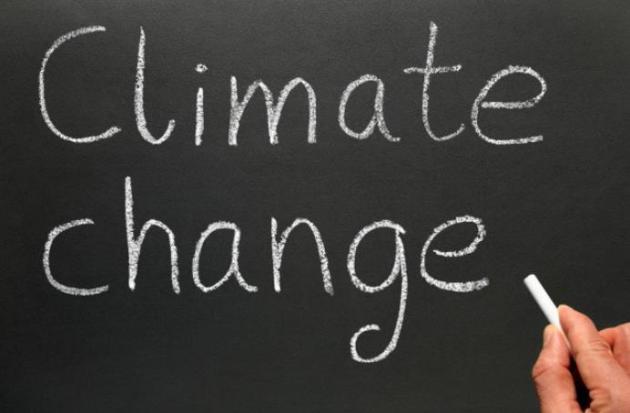
Photo credit above: Nati Harnik, AP.
Does a Carbon Tax Work? Ask British Columbia. Here's a clip from an analysis at The New York Times: "...In
2008, the British Columbia Liberal Party, which confoundingly leans
right, introduced a tax on the carbon emissions of businesses and
families, cars and trucks, factories and homes across the province. The
party stuck to the tax even as the left-leaning New Democratic Party
challenged it in provincial elections the next year under the slogan Axe
the Tax. The conservatives won soundly at the polls. Their experience
shows that cutting carbon emissions enough to make a difference in
preventing global warming remains a difficult challenge. But the most
important takeaway for American skeptics is that the policy basically
worked as advertised..."
Photo credit above: "A
Lafarge cement plant in Richmond, British Columbia. Cement makers,
whose business is energy-intensive, said imports from China and the
United States increased when the carbon tax was instituted." Credit via Cement Association of Canada.
Image Credit: Leaflet via a Wiki CC BY-SA 3.0 License
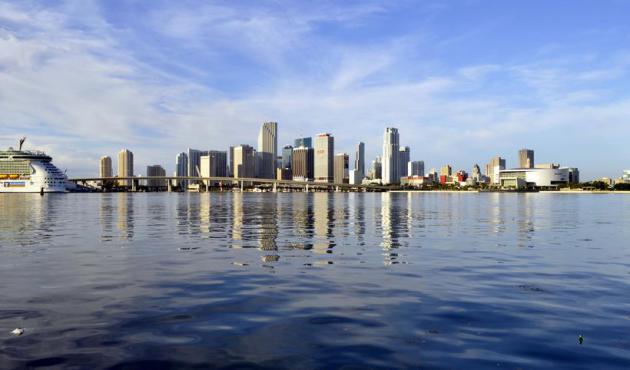
No comments:
Post a Comment